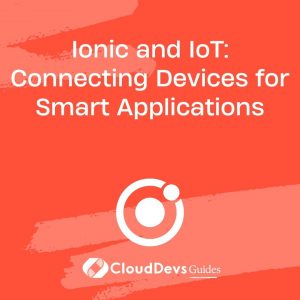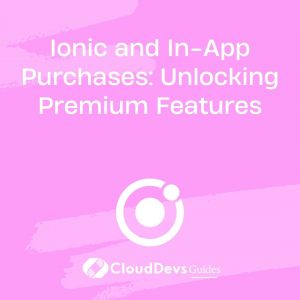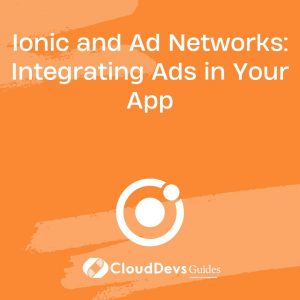Ionic and IoT: Connecting Devices for Smart Applications
In a world driven by technology, the Internet of Things (IoT) has emerged as a transformative force, connecting physical devices to the digital realm. Meanwhile, Ionic, a popular framework for building cross-platform mobile and web applications, has gained significant traction for its versatility and ease of use. When these two technologies come together, a world of possibilities opens up for creating smart applications that harness the power of IoT.
Table of Contents
1. Understanding IoT and Its Potential
The Internet of Things (IoT) is a network of physical objects embedded with sensors, software, and other technologies that enable them to collect and exchange data over the internet. These objects, which can range from everyday appliances to industrial machinery, become “smart” when they can interact with each other and make decisions based on the data they collect.
IoT has the potential to revolutionize various industries, including healthcare, agriculture, manufacturing, and transportation. It enables businesses to make data-driven decisions, automate processes, and improve efficiency. Imagine a world where your thermostat adjusts itself based on your preferences, or where farmers receive real-time data on soil conditions to optimize crop yield.
2. The Versatility of the Ionic Framework
Ionic is an open-source framework that allows developers to build cross-platform mobile and web applications using web technologies such as HTML, CSS, and JavaScript. What sets Ionic apart is its ability to create high-quality, native-like experiences on multiple platforms, including iOS, Android, and the web, all from a single codebase.
Here are some key advantages of using Ionic for your app development needs:
2.1 Cost-Effective Development
Developing separate applications for iOS and Android can be expensive and time-consuming. Ionic’s cross-platform capabilities save both time and money, as developers can write code once and deploy it across multiple platforms.
2.2 Native-Like User Experience
Ionic leverages web technologies to create applications that look and feel like native apps. Users won’t notice a significant difference in performance or usability compared to traditional native development.
2.3 Extensive Library of UI Components
Ionic provides a rich set of UI components and pre-built elements that streamline the development process. These components are designed to be highly customizable, allowing developers to create unique and visually appealing interfaces.
2.4 Access to Native Device Features
Ionic allows access to native device features through plugins, making it possible to integrate device-specific functionality like geolocation, camera access, and push notifications into your app.
3. Building an IoT-Powered Ionic App
Now that we understand the potential of IoT and the advantages of the Ionic framework, let’s dive into how to build an IoT-powered Ionic application. This section will cover the essential steps to get you started.
3.1 Setting Up the Development Environment
Before you can start building your Ionic app, you’ll need to set up your development environment. Here are the basic steps:
Step 1: Install Node.js and npm
Ionic relies on Node.js and npm (Node Package Manager) for package management. Install Node.js from the official website (https://nodejs.org/) and npm will come bundled with it.
Step 2: Install Ionic CLI
You can install the Ionic CLI globally using npm:
bash npm install -g @ionic/cli
Step 3: Create a New Ionic Project
Use the following command to create a new Ionic project:
bash ionic start my-iot-app blank
This command will generate a new Ionic project named “my-iot-app” based on the “blank” template.
Step 4: Navigate to Your Project Folder
bash cd my-iot-app
3.2 Connecting to IoT Devices
To connect your Ionic app to IoT devices, you’ll need to use appropriate IoT protocols and libraries. Depending on your IoT devices, you might work with protocols like MQTT, HTTP, or WebSocket. Here’s a simplified example using HTTP to connect to an IoT device:
javascript
// Import the HTTP module
import { HttpClient } from '@angular/common/http';
// Create a service to interact with your IoT device
@Injectable({
providedIn: 'root'
})
export class IoTService {
// Define the IoT device's API URL
private apiUrl = 'https://your-iot-device-api.com';
constructor(private http: HttpClient) { }
// Function to fetch IoT data
getIoTData() {
return this.http.get(`${this.apiUrl}/data`);
}
// Function to send commands to the IoT device
sendCommand(command: string) {
return this.http.post(`${this.apiUrl}/command`, { command });
}
}
In this example, we use Angular’s HttpClient to make HTTP requests to your IoT device’s API. Remember to replace the apiUrl with your actual IoT device endpoint.
3.3 Leveraging IoT Data
Once you’ve established a connection to your IoT device, you can leverage the data it provides in your Ionic app. Displaying IoT data in real-time or using it to trigger events within your app opens up various possibilities.
javascript
// Inside your Ionic component
import { Component } from '@angular/core';
import { IoTService } from './iot.service';
@Component({
selector: 'app-iot',
templateUrl: './iot.page.html',
styleUrls: ['./iot.page.scss'],
})
export class IoTPage {
// Store IoT data
public iotData: any;
constructor(private iotService: IoTService) { }
// Fetch IoT data when the page loads
ionViewWillEnter() {
this.iotService.getIoTData().subscribe((data) => {
this.iotData = data;
});
}
}
In this example, we fetch IoT data using the IoTService we created earlier and display it in an Ionic component.
4. Real-World Applications
The combination of Ionic and IoT opens up a world of possibilities for real-world applications. Here are a few examples:
4.1 Smart Home Control
With IoT sensors and devices integrated into your home, you can build an Ionic app that allows you to control lights, thermostats, and security systems from your smartphone.
4.2 Healthcare Monitoring
IoT-enabled medical devices can transmit patient data to an Ionic app, enabling healthcare professionals to monitor and react to critical changes in real-time.
4.3 Industrial Automation
In industrial settings, Ionic apps can connect to IoT sensors and machinery to improve efficiency, reduce downtime, and monitor equipment health.
4.4 Agriculture Optimization
Farmers can use IoT sensors to collect data on soil conditions, weather, and crop health. An Ionic app can provide insights to optimize crop management.
5. Challenges and Considerations
While Ionic and IoT offer tremendous potential, there are also challenges and considerations to keep in mind:
5.1 Security
Security is paramount when dealing with IoT data. Ensure that your IoT devices and communication channels are adequately secured to protect sensitive information.
5.2 Scalability
As the number of IoT devices increases, your app should be able to handle a growing amount of data and connections. Scalability is a crucial factor to consider.
5.3 Compatibility
Different IoT devices may use different protocols and data formats. Ensure that your Ionic app can handle a variety of IoT devices and data sources.
Conclusion
The fusion of Ionic and IoT is a game-changer in the world of app development. It enables the creation of smart applications that can interact with and control physical devices, opening up new possibilities in various industries.
By understanding the potential of IoT, harnessing the versatility of the Ionic framework, and following best practices, you can embark on a journey to develop innovative, IoT-powered applications that shape the future of technology. Whether it’s creating smart homes, revolutionizing healthcare, or optimizing industries, the combination of Ionic and IoT holds the key to a smarter and more connected world. Start exploring the endless possibilities today!
Table of Contents








